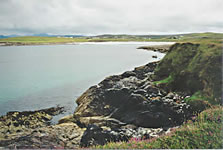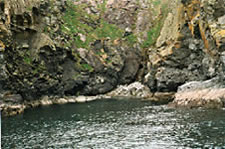|
| cleggan |
If you travel along the bog road towards Cleggan on a fresh clear morning in spring or early summer, or indeed, anytime of the year, and get the first view of the village and the bay sheltered by Cleggan Hill from the North, the beauty of the scenery grips you. The peace and calmness make you feel you have discovered Heaven on earth, a place you never want to leave again.
Cleggan is a small sleepy fishing village at the head of Cleggan Bay. An impressive looking Pier built by Alexander Nimmo in 1822 and extended in 1908 is the main feature. It boasts four bars, one grocers, a post office, a restaurant, a take away, and of course 1km past the village the Ocean Wave Bed and Breakfast, which over looks Cleggan Bay and Inish Boffin Island among many other Islands which is surrounded by three beaches, a home form home stay guaranteed. Their motto is ‘There is no strangers here only friends we never met’. |
| Cleggan Head |
| An Cloigeann means head or skull, so obviously the name has to do with the doomed headland. But local folklore has a different and much more enticing explanation. St Ceannanach from the Aran Islands is supposed to have been beheaded by a tyrant nearby. He picked up his head, took it to the Holy Well in Clooncree. There is a very fine court tomb near to Cleggan Head. |
| The Cleggan Bay Disaster | |
On October 28th 1927, the village was struck by great grief when twenty six men were lost at sea. On the last Friday of the month the men, as usual, got ready to go fishing. Their nets were scarcely shot when a gale from the North West broke without the slightest warning, whipping that comparatively calm sea into a foaming mass of rushing water. The frantic cry from the white-washed cabins was ‘Oh God who walked the waters once, bring them safely home’.
From the village of Rossadilisk sixteen men were lost and nine from the Inish Bofin, and twenty men lost also from County Mayo. A grim reminder of the tragedy is the tall Celtic Cross in limestone which dominates the tide-besieged graveyard overlooking Omey Strand. There are sixteen names inscribed thereon and the date.
Some of the men lost were never found. What utter woe that fateful night brought to the widows, orphans and aged mothers in the fishing hamlet of Rossadilisk and Inish Bofin, can be conceived only by those who walked among them in the first hours of their great loss. What a turning point that date marked in the philosophy of life and the economic outlook of the entire Western fishfolk can be realised only by those who knew them before and after the “Cleggan Bay Disaster”. |
| The Cleggan Bay Disaster written by Marie Feeney |
| A book now is available on this story of one fateful night in the life of two communities-a night that changed the course of local history. Although it is the story of one story of one specific maritime tragedy in the west of Ireland. It is one that will strike familiar chords in small fishing communities, not only around the coast of Ireland, but anywhere that people pit their wits against weather and ocean. This book is called The Cleggan Bay Disaster written by Marie Feeney, granddaughter of one of the survivors, her personal interest has ensured readers of a story told sensitively, and with sympathetic attention to detail. |
| Beaches and Cliffs |
| There is an abundance of fine beaches in the Cleggan area. Cleggan beach on the Ballynew road you can see from the village. Park the car and go walking in your bare feet on the lovely sand or go swimming if you like. It is a great place for surfing too. There are lots of things to do in the Cleggan area, pony trekking, deep sea angling, and hill or mountain climbing are only a few examples. If you are adventurous, you can walk up Cleggan Head, your reward will be breathtaking views, the massive cliffs, the local people will tell you, are as nice as the Cliffs of Moher any day of the week. Do not walk too near the edges, as they have been severely undercut in places. The water here is so clear that, with a bit of luck, you might even see a seal swimming under water. |
| A Walk along the Shore |
If you have not run out of energy by now, walk right up to the summit of Cleggan Hill. Here your eyes can not only feats on the view but take in the remains of Cleggan Tower, a signal tower built in 1816 when invasion by Napoleons troops was feared. It was destroyed by hurricane ‘Debbie’.
Sellerna Beach is just a short walk from Cleggan village. There is a megalithic tomb down the end of the road to this beach up on the hill to the right. Some of the old people say there is a giant buried under it with all its treasures. If you go to the left of the beach you will see what used to be a river, but in January 1991it was torn apart by the storm and the sea. If you keep walking to the left you can walk along the cliffs to Rossadillisk beach, and go rod fishing on the rocks. There is also a road to Rossadillisk beach which is well sign-posted. |
| ST. Feichin’s church |
There are many things to see on the island. The graveyard named ST. Brendan’s altar (ula bhreandain) where six teen fisherman after the cleggan disaster were laid to rest. Tobar Feichin, a holy well with a shrine around it in Gooreen, or the ruins of ST. Feichin’s church on the north side of the island. In 1981 some local people took an interest in ST Feichin’s church which was under tons of sand for centuries. Saiint Feichins came to Omey shortly after his ordination around 610 A.D. and had a difficult time converting the people on and around Omey. Saint Feichin’s day is celebrated on the 14th of January every year. The mass is held in the ruins in the church which makes you feel as if you are going back to the time when he said mass himself, a lovely feeling as if you were taking the place of your forefathers.
|
| A Trip to Bofin |
| Trips to Inishbofin leave Cleggan Pier about three times daily depending on the weather and demand. You can buy your tickets from local outlets. The trip takes about forty five minutes. There are two hotels, two bars, a restaurant, a hostel and lovely sandy beaches on the Island. The population before the Famine was about 1,400, now there are about 180 people living on the Island. In Irish the Island is called “Inis bo finne”, meaning the Island of the White Cow. | |
A Magical Place of Mists and MysteryLegend says it was originally a magical place of mists and mystery, an island constantly covered in mist in the Western Ocean. Two fishermen came across it when they were out fishing and got lost in the thick fog. They soon became very hungry. They had a lighted sod of peat, on a slate in the currach. The fire made the mist disperse and as a result the Island was discovered. When they landed on the Island they saw an old woman driving a white cow before her. As they came closer the woman ran off. One man chased the white cow and caught her by the tail, the tail broke off and the cow burned into a stone of white quartz. The man was left holding a sea rod. The second man came upon the old lady on the edge of a nearby lake. The lake is now called Loch Bo Finne, or lake of the White Cow.
From Inishbofin Harbour, which has called one of the most beautiful natural harbours in the world, you can see the remains of castle built by Grace O’ Malley who fortified the Island for her large fleet of ships in Elizabethan times. In 1652, it became a garrison post and then a prison island for priests and troublesome enemies of Cromwell. Near the castle a prehistoric field system and hut sites have been discovered. |
| Omey Island Walk |
One of the most interesting walks to be found around the Cleggan Peninsula is on Omey Island (Iomaidh Feichin-St. Feichin’s Bed). At the church in Claddagduff take the road to the left and walk down to the strand. The timing of this adventure is most important. At low tide you can walk across the strand to the island. To the left and right of you is the sea which covers the hard packed sand at high tide so be sure to check the tide charts for the best time to cross if you are on foot. As you come up onto the island to your right you will see a graveyard. The view of the graveyard from the strand seems to give one the feeling that those buried there are indeed in their right place for the stones appear to lean toward the sea in reverence. A few hundred yards around to the north is the Little Hill of the Woman where there are the remains of cemetery dedicated exclusively to woman. To the left and up the road is Cloon. Here is the site of Omey House built in1789 and destroyed in a powerful storm in 1839. If you walk along the shoreline of Omey in the sandbank you will find evidence of layers of small shells, used for dying, and burnt stone rising up the sandbanks. This apparently is the site of an ancients settlement.
From this point on Omey the walking starts to become less easy but the views are breathtaking. Out across the water can be seen Crow Island, uninhabited except for the seals and dolphins that cavort in the bay on the back side of the island. On a brisk windy with the sun glancing off the sea and the spray from the breakers pounding on the shore the sheer joy in being there overpowers any weather worries. It is akin to being on a tropical island, with the ocean boiling up through the rock crags and the huge boulders protecting the inner island. It’s a mite colder than the tropics.
On around the island is the ruin of St. Feichin’s Church which, until 1981, was buried in the sands. Standing here in the sunlight one gets the impression that the Spirit of the Saint for whom the island is named is watching and blesses the visit. Near the church are the remains of a cemetery for men. One wonders why the men and women were separated in death and if they hover over the lovely place in unison to protect all whom pass. Omey Island abounds with history and mystery, with a mixture of the ancient and the contemporary. It calls to the traveller to enjoy its wondrous places and captivating scenery....., and to remember that the timing is in the tides. |
We are the music-makers and we are the dreamers of dreams, wandering by lone sea-breakers, and sitting by desolate streams. Arthur O’ Shaughnessy
|  | Copyright Marie Feeney 2002 |
| BACK |
| | | |




